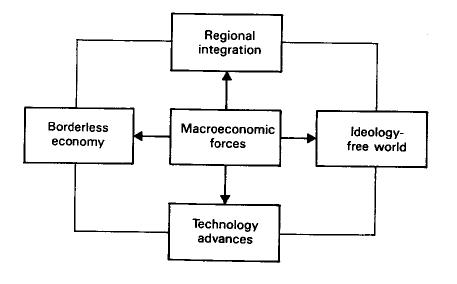In this IMR issue, the editors and authors have eloquently discussed and described the macroeconomic forces that shape marketing strategies both domestically and globally. I will, therefore, focus more on the implications of these macroeconomic forces on reshaping marketing strategies and less on their description, beginning with a brief discussion of four major macroeconomic forces that are shaping marketing strategies and practices.
A Framework for Macroeconomic Forces
There are four major macroeconomic forces that are shaping international business and marketing strategies. They are: regional integration and the emergence of the triad power; technology advances, especially the adoption of information technologies in business operations; the emergence of an ideologyree world and the role of the market economy policy; and finally; a borderless economy as a consequence of global sourcing and global competition. This is represented in Figure 1.
Regional Framework
Regional integration of Western Europe (EC92) and Southeast Asia (ASEAN) have recently demonstrated that nations can gain more competitive advantages -‘ its ‘ enduring alliances than by self-reliance or bilateral trade agreements (Porter, 1990). The emerging economic power of “Europe 92” is, in turn, creating a marketing domino effect on the rest of the world. For example, it is encouraging North American regional integration between the United States, Canada and Mexico; Japan is attempting to align with the ASEAN bloc. The triad of Europe, Japan and the United States dominate the world economy today (Ohmae, 1985). It is estimated that 75 per cent of the world GDP and 70 per cent of world trade are concentrated in these three regional economic blocs.
Regional integration is not a new concept. It has been practised by kings and emperors in ancient times and by colonial powers in more modem times (Kennedy, 1987). In fact, the United States, after the Civil r, created regional integration among all its states which resulted in several competitive advantages against dominant European nations such as England, France and Germany What is new are two things: first the emergence of three economic superpowers is replacing the old model of a single economic superpower ruling the world; second, the three superpowers are highly interdependent in their economic activities through mutual presence and mutual trade. The future of each one is increasingly dependent on the future of the others, resulting in the need for greater co-operation and understanding.
Technology Advances
Technology advances, especially in electronics, have revolutionized business processes and practices (Gerstein, 1987; Guile and Brook, 1987). Computerization of people, machinery and physical facilities has literally reshaped the traditional economic concepts of scale, scope and structure. Similarly, improvement in telecommunications and information technologies has reduced the time and place barriers of doing business. It is no exaggeration to suggest that traditional marketing theories based on location (for example, the law of retail gravitation, wheel of retailing, inventory management, logistics and physical distribution) may be obsolete when customers and suppliers can do business at any time and from anywhere. Finally, electronics advances are resulting in market egalitarianism. The traditional trickle-down theory of markets (from government to industrial to services to consumer markets) for diffusion of technology and products is being replaced by simultaneous introduction of technology to all markets. Better yet, the trickle-up theory (from consumer to services to industrial markets) is now evident as shown by the use of transistors in personal radios prior to computers; or mass marketing of television prior to the emergence of CRT; or the use of compact disc (CD-ROM) in personal entertainment prior to storage of library information.
In a later section this egalitarian and convergent nature of the electronics technology is discussed with regards to how it will challenge such well known concepts as diffusion of innovation theory and product-market definitions in marketing strategy.
Ideology-free World
A thin macroeconomic force is the economic collapse of ideology-driven nations, especially the communist countries. As governments become more pragmatic and remain less ideology-driven, it is inevitable that many of the traditional beliefs about the role of the market economy and private enterprises will change (Drucker, 1989; Burnstein, 1991). This is likely to result in privatization of the public sector; less regulation of most industries; and development of pro-competitive policies to encourage innovation and the efficiency at different sectors of the economy. This is bound to blur the marketing practices of profit versus non-profit entities and industries. Also, significantly different market practices across nations, which were based on government trade and employment policies, are likely to give way to more market-based marketing practices in the future.
Borderless Economy
Finally, and probably as a consequence of the other three macroeconomic forces, there is increasing globalization of the domestic economy, primarily through global sourcing and global competition. Marketing practices will have to understand and adjust to this reality of a borderless economy (Ohmae, 1990). Borderless markets emerge when four flows are driven by market practices and without government intervention (Reich, 1991) — these are the flows of products/services, people, money and information. In a borderless economy, marketing practices related to procurement, marketing mix and customer understanding are bound to change.
Emerging Market Practices
These macroeconomic forces are certainly impacting on market practices. Indeed, they may be capable of creating several paradigm shifts in marketing. Consequently, doing faster and better may not be sufficient and, instead, businesses will be required to develop new marketing concepts and practices (Kotler, et al., 1985; Rosow, 1988; Thurow, 1985).
Ten emerging market concepts and practices are identified as a consequence of macroeconomic forces. These are represented in Figure 2. Some of them may be more immediate in their emergence while others may take some time; some of them may be more appropriate for services marketing while others may be for products marketing; finally, some of them may be easy to implement, while others may face strong resistance.
Borderless Marketing
Marketing concepts such as market segmentation, product differentiation, and buyer behavior, as well as marketing practices related to product, price, promotion and distribution will require global orientation as technology, regional integration and market economy processes create borderless marketing. This likely to reduce the importance of international marketing and enhance the
teed for global marketing concepts and practices. Even companies totally focused on domestic markets will have to incorporate a global perspective in their strategic and operational planning processes to include global competition and ourcing (Davis, 1987; Davis and Davidson, 1991).
Relationship Marketing
As the political and regulatory climate encourages free market processes, it becomes more difficult to sustain market leadership based on short-term sales- oriented transaction marketing. It becomes increasingly necessary to rely on customers to pre-empt competition, especially offshore competition. This is likely to encourage marketing practitioners to practise customer retention economics and enter into ongoing relationship marketing with their suppliers and customers on a global basis (Davis and Davidson, 1991).
Fifth “P” of Marketing
As the geopolitical dynamics of the world restructure markets and competition, it becomes increasingly important to actively shape the policy of the nations and regional blocs to ensure that the timing and nature of restructuring will be manageable. This is referred to as the fifth “P” of marketing and implies that policy shaping is equally influential and should be practised simultaneously along with the traditional four “Ps” of marketing. Unfortunately practitioners do not know how to blend the fifth “F’ into their marketing mix and the academics do not have an integrative conceptual framework which incorporates the fifth “P” of marketing (Kotler, 1987).
Mass Customization
As markets become borderless, they will be segmented not only by national characteristics, but also by customer or user characteristics. In other words, intranational differences on a global basis will be equally as important as international differences. This will require the oxymoron marketing of “think
global, act local”. In other words, global market segments based on user characteristics will need customization to physical, economic and cultural localization. One way to manage this oxymoron is the practice of mass customization in which each element of the marketing mix (product, price, promotion and distribution) is based on standard platforms or architecture, but it is customized to unique applications (Davis, 1987).
Anticipatory Innovation
As market opportunities expand due to an ideology-free world and regional integration, and as technology advances generate breakthrough innovations, it will become increasingly necessary for marketing practitioners to anticipate what customers want or need. Customers often do not know how breakthrough technologies can enable them to increase their value (performance-price ratio).
While marketing practitioners are very good in responding to market demands, they tend to do less well (especially in cross-national settings) in anticipating what markets will buy (Sheth and Ram, 1987).
Customer-focused Quality
The definition and practice of quality of all marketing activities, which includes product, selling and customer service, will change from operations-focused to customer-focused. This means that quality does not necessarily imply a long life, but consistency of performance or reliability. Marketing practices in the future will be judged as superior or inferior on the consistency dimensions across time and place dimensions (Lele and Sheth, 1987).
Trickle-up Marketing
Technology advances created by the electronics revolution suggest that marketing to the least affordable market may generate more efficient marketing practices than marketing to the elite (Davis, 1987). In other words, introducing new products first to less developed nations or less developed segments and upstreaming the markets may allow firms to learn, by trial and error, more efficiently. This means penetration marketing becomes more prevalent than skimming marketing.
Value-based Marketing
Marketing concepts and practices have been traditionally based on volume or weight as a unit of analysis for costing and pricing. In the future, marketing practices will have to cost and price products and services more based their 3rketng time and place associated values. This is often prevalent in the services sector, view but is not consciously practised in the products sector.
Coverage Marketing
As borderless markets become accessible by technology advances, it will become increasingly necessary to develop market coverage concepts and marketing practices that will be based more on availability and exposure aspects, and less on location and comparative aspects of a marketing mix, including product and promotion.
Networked Marketing
Cross-functional processes will be increasingly important as markets become global and volatile. It will become increasingly important for the left hand to know what the right hand is doing, especially at the market boundary or frontline personnel level in procurement, manufacturing, selling and servicing market offerings. Fortunately, online information technologies are becoming increasingly affordable to network the organization.
Summary and Conclusions
Macroeconomic forces have been always important in marketing practice. Unfortunately, marketing scholars have treated them as ceteris paribus or exogenous variables. Consequently, they have failed to develop conceptual frameworks which consciously incorporate their influence on marketing practices.
In this article, macroeconomic forces are aggregated into four categories:
regional integration, ideology-free world, technology advances and borderless economy. By examining changes in these macroeconomic forces, ten emerging marketing strategies to respond effectively to these forces are proposed. These include, among others, borderless marketing, relationship marketing, mass customization, trickle-up marketing and networked marketing.
References
Burnstein. D. (1991), Euroquake. Simon & Schuster, New York.
Davis, S.M. (1987), Future Perfect, Addison-Wesley, Waltham. MA.
Davis, S.M. and Davidson, W. (1991), 2020 Vision, Simon and Schuster. New York.
Drucker. p. (1989), The New Realities, Harper & Row, New York.
Gerstein, MS. (1987), The Technology Connection, Addison-Wesley, Reading. MA.
Guile. B. and Brook, H. (Eds.) (1987), Technology and Global Industry. National Academy Press, Washington, DC.
Kennedy, P. (1987), The Rise and Fall 0/the Great Powers, Random House. New York.
Kotler. P. (1987), “Broadening the Concept of Marketing Further: The Megamarketing Concept”, in Frazier, G. and Sheth, J.N. (Eds.), Contemporary Views on Marketing Practice, Lexington Books, Lexington, MA pp. 3-17.
Kotler, P. Fahey, L. and Jatusn Pitak. S. (1985), The New Competition, Prentice-Hall, Englewood Cliffs, NJ.
Lele, M. and Sheth, J. (1987), The Customer is Key, John Wiley & Sons, New York. Ohmae. K. (1985), Triad Power, Free Press. New York.
Ohmae, K. (1990), The Borderless World, Harper Business. New York.
Porter, M. (1990), The Competition Advantage of Nations, Free Press, New York.
Reich, R.B. (1991), The Work of Nations, Knopf. New York.
Rosow, J.M. (Ed.) (1988). The Global Marketplace, Facts on File, New York.
Sheth, J.N. and Ram, S. (1987), Bringing Innovation to Market, John Wiley & Sons, New York.
Thurow, L. (Ed.) (1985), The Management Challenge, MIT Press, Cambridge, MA.






